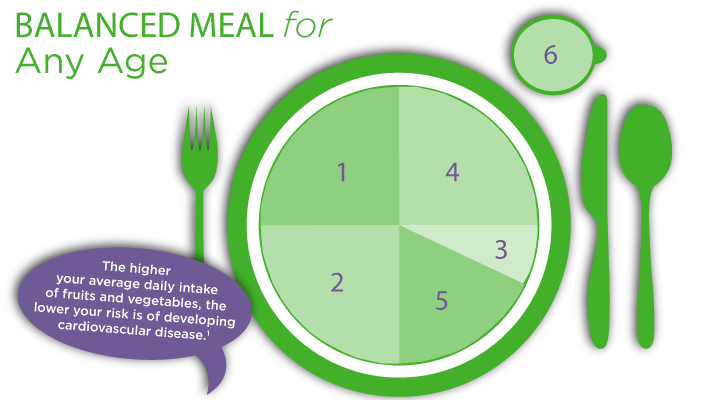A balanced meal includes the nutrients and vitamins that we need to power through our day. That fuel comes from a combination of different foods from leafy greens to seafood dinners. The right balanced combination of food groups gives you a healthy body and mouth! But, eating the wrong foods in the wrong proportions can lead to poor oral and overall health. In order to get the proper nutrition for healthy aging, we have to be aware of what a healthy plate looks like and take the time to eat right.
As we get older, the things we eat and drink become impactful. The longer we have poor nutritional habits, the longer it takes our mouth and body to recover. For nutrition that promotes healthy aging, follow these recommendations in our handy infographic with information compiled from the U.S. Department of Agriculture, Harvard School of Public Health, and Healthline.
1. Fruits – Whole fruits are much healthier than fruit juice. Your fruits and veggies should make up half of what you eat each day. Fresh, frozen, dried, or canned – they all count! Try adding a fruit smoothie to your morning routine.
2. Vegetables – No single vegetable can give you all the nutrients your body needs, so switch up your sides between green beans and leafy greens (calcium, iron, and cardiovascular health), red and orange veggies (lowers LDL cholesterol and blood pressure), and cruciferous veggies like broccoli (vitamins and folate).
The higher your average daily intake of fruits and vegetables, the lower your risk is of developing cardiovascular disease.
3. Grains – Eating whole grains can lower your risk for chronic diseases. Whole grains should make up half your daily grain intake. They provide dietary fiber that may help reduce blood cholesterol levels and lower risk of heart disease, obesity, and type 2 diabetes.
4. Dairy – Dairy products are made from milk and retain their calcium. Foods made from milk that have little to no calcium like cream cheese, cream, and butter, are not considered dairy. Calcium-fortified soymilk, almond milk, and other nut milks are part of the Dairy Group. The calcium in dairy is vital to bone health. Diets that provide 3 cups or the equivalent of dairy products per day can improve bone mass.
5. Protein – Meat, poultry, fish, eggs, nuts, and seeds supply essential nutrients we need to have energy. Some protein, like fatty cuts of meat, are less healthy because they are high in bad cholesterol. It’s recommended we eat 8 ounces of seafood per week to avoid that. Eating a variety of seafood also contributes to the prevention of heart disease.
6. Fluids- What you drink is equally as important and influential as what you eat. When you’re thirsty, reach for water and let your thirst determine how much water to drink in a day. Other options like low-fat or fat-free milk, or 100% juice are great to keep around your home. If you do stray to sugary beverages, make sure you’re following the serving size recommendation.
Healthy Oils – Oils provide us with necessary fatty acids and vitamin E. Soybeans, olives, corn, sunflowers, and peanuts all contain healthy oils. Choose unsaturated oils instead of saturated fat for healthy eating habits. Some plant oils like coconut and palm oil are higher in saturated fat, so be aware and eat them less often.
Herbs and Spices – Not only do they add some fun and flavor to a meal, herbs and spices also have great health benefits. Cinnamon lowers blood sugar and has a powerful anti-diabetic effect. Sage improves brain function and memory, and peppermint is great for stomach and digestion issues. Turmeric, a savory yellow spice, has several nutritious qualities and helps soothe inflammation.
Did you know that what you eat impacts your smile health? The nutrients from these foods directly contribute to having healthy gums, teeth, and an overall healthy mouth.
If you’re concerned your diet has impacted your oral health, maybe it’s time to visit the dentist.



